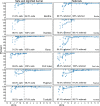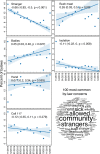Community engagement in outbreak response: lessons from the 2014-2016 Ebola outbreak in Sierra Leone
- PMID: 32830128
- PMCID: PMC7445350
- DOI: 10.1136/bmjgh-2019-002145
Community engagement in outbreak response: lessons from the 2014-2016 Ebola outbreak in Sierra Leone
Abstract
Documentation of structured community engagement initiatives and real-time monitoring of community engagement activities during large-scale epidemics is limited. To inform such initiatives, this paper analyses the Community Led Ebola Action (CLEA) approach implemented through the Social Mobilization Action Consortium (SMAC) during the 2014-2016 Ebola epidemic in Sierra Leone. The SMAC initiative consisted of a network of 2466 community mobilisers, >6000 religious leaders and 42 local radio stations across all 14 districts of Sierra Leone. Community mobilisers were active in nearly 70% of all communities across the country using the CLEA approach to facilitate community analysis, trigger collective action planning and maintain community action plans over time. CLEA was complemented by interactive radio programming and intensified religious leader engagement.Community mobilisers trained in the CLEA approach used participatory methods, comprised of an initial community 'triggering' event, action plan development and weekly follow-ups to monitor progress on identified action items. Mobilisers collected operational and behavioural data on a weekly basis as part of CLEA. We conducted a retrospective analysis of >50 000 weekly reports from approximately 12 000 communities from December 2014 to September 2015. The data showed that 100% of the communities that were engaged had one or more action plans in place. Out of the 63 110 cumulative action points monitored by community mobilisers, 92% were marked as 'in-progress' (85%) or 'achieved' (7%) within 9 months. A qualitative examination of action points revealed that the in-progress status was indicative of the long-term sustainability of most action points (eg, continuous monitoring of visitors into the community) versus one-off action items that were marked as achieved (eg, initial installation of handwashing station). Analysis of behavioural outcomes of the intervention indicate an increase over time in the fraction of reported safe burials and fraction of reported cases referred for medical care within 24 hours of symptom onset in the communities that were engaged.Through CLEA, we have demonstrated how large-scale, coordinated community engagement interventions can be achieved and monitored in real-time during future Ebola epidemics and other similar epidemics. The SMAC initiative provides a practical model for the design, implementation and monitoring of community engagement, integration and coordination of community engagement interventions with other health emergency response pillars, and adaptive strategies for large-scale community-based operational data collection.
Keywords: Community Engagement; Ebola; Sierra Leone.
© Author(s) (or their employer(s)) 2020. Re-use permitted under CC BY. Published by BMJ.
Conflict of interest statement
Competing interests: None declared.
Figures



Similar articles
-
Integrated digital system for community engagement and community-based surveillance during the 2014-2016 Ebola outbreak in Sierra Leone: lessons for future health emergencies.BMJ Glob Health. 2020 Dec;5(12):e003936. doi: 10.1136/bmjgh-2020-003936. BMJ Glob Health. 2020. PMID: 33355270 Free PMC article. Review.
-
Unmet needs and behaviour during the Ebola response in Sierra Leone: a retrospective, mixed-methods analysis of community feedback from the Social Mobilization Action Consortium.Lancet Planet Health. 2020 Feb;4(2):e74-e85. doi: 10.1016/S2542-5196(20)30008-5. Epub 2020 Feb 26. Lancet Planet Health. 2020. PMID: 32112750 Free PMC article.
-
'When Ebola enters a home, a family, a community': A qualitative study of population perspectives on Ebola control measures in rural and urban areas of Sierra Leone.PLoS Negl Trop Dis. 2018 Jun 8;12(6):e0006461. doi: 10.1371/journal.pntd.0006461. eCollection 2018 Jun. PLoS Negl Trop Dis. 2018. PMID: 29883449 Free PMC article.
-
A practical community-based response strategy to interrupt Ebola transmission in sierra Leone, 2014-2015.Infect Dis Poverty. 2016 Aug 5;5(1):74. doi: 10.1186/s40249-016-0167-0. Infect Dis Poverty. 2016. PMID: 27491387 Free PMC article.
-
The 2014 West Africa Ebola crisis: lessons from UK Defence Healthcare Engagement in Sierra Leone.BMJ Mil Health. 2024 Jul 19;170(e1):e70-e74. doi: 10.1136/military-2023-002665. BMJ Mil Health. 2024. PMID: 38897642 Review.
Cited by
-
Integrated digital system for community engagement and community-based surveillance during the 2014-2016 Ebola outbreak in Sierra Leone: lessons for future health emergencies.BMJ Glob Health. 2020 Dec;5(12):e003936. doi: 10.1136/bmjgh-2020-003936. BMJ Glob Health. 2020. PMID: 33355270 Free PMC article. Review.
-
Using Community Feedback to Guide the COVID-19 Response in Sub-Saharan Africa: Red Cross and Red Crescent Approach and Lessons Learned from Ebola.Health Secur. 2021 Jan-Feb;19(1):13-20. doi: 10.1089/hs.2020.0195. Epub 2021 Jan 27. Health Secur. 2021. PMID: 33497272 Free PMC article.
-
Effective community engagement in one health research in Sub-Saharan Africa: a systematic review.One Health Outlook. 2025 Jan 15;7(1):4. doi: 10.1186/s42522-024-00126-4. One Health Outlook. 2025. PMID: 39810220 Free PMC article. Review.
-
Barriers to community engagement during the response to an Ebola virus disease outbreak in Uganda.BMJ Glob Health. 2025 Mar 11;10(3):e017285. doi: 10.1136/bmjgh-2024-017285. BMJ Glob Health. 2025. PMID: 40068928 Free PMC article.
-
Evaluation of Community Perceptions and Prevention Practices Related to Ebola Virus as Part of Outbreak Preparedness in Uganda, 2020.Glob Health Sci Pract. 2022 Jun 29;10(3):e2100661. doi: 10.9745/GHSP-D-21-00661. Print 2022 Jun 29. Glob Health Sci Pract. 2022. PMID: 36332065 Free PMC article.
References
-
- IFRC From word to action: towards a community-centered approach to preparedness and response in health emergencies. Global Preparedness Monitoring Board 2019.
-
- World Health Organization Social mobilization in public health emergencies: preparedness, readiness and response: report of an informal consultation, Geneva, Switzerland, 10–11 December 2009, tech. Rep. Geneva: World Health Organization; 2010. https://www.who.int/csr/resources/publications/HSE_GAR_BDP_2010_1/en/
-
- World Health Organization, UNICEF . Communication for behavioural impact (combi): a toolkit for behavioural and social communication in outbreak response, 2012. Available: https://www.who.int/ihr/publications/combi_toolkit_outbreaks/en/
Publication types
MeSH terms
Grants and funding
LinkOut - more resources
Full Text Sources
Medical
